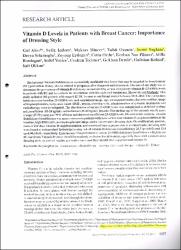| dc.contributor.author | Alço, Gül | |
| dc.contributor.author | İğdem, Şefik | |
| dc.contributor.author | Dinçer, Maktav | |
| dc.contributor.author | Özmen, Vahit | |
| dc.contributor.author | Sağlam, Sezer | |
| dc.contributor.author | Selamoğlu, Derya | |
| dc.contributor.author | Okkan, Sait | |
| dc.date.accessioned | 2015-09-15T11:50:52Z | |
| dc.date.available | 2015-09-15T11:50:52Z | |
| dc.date.issued | 2014 | |
| dc.identifier.citation | Alco G, Igdem S, Dincer M, Ozmen V, Saglam S, Selamoglu D, Erdogan Z, Ordu C, Pilanci KN, Bozdogan A, Yenice S, Tecimer C, Demir G, Koksal G, Okkan S. Vitamin D levels in patients with breast cancer: importance of dressing style. Asian Pac J Cancer Prev. 2014;15(3):1357-62. doi: 10.7314/APJCP.2014.15.3.1357 | en_US |
| dc.identifier.issn | 1513-7368 | |
| dc.identifier.uri | http://www.apocpcontrol.org/ | en_US |
| dc.identifier.uri | https://hdl.handle.net/11446/787 | en_US |
| dc.description | İstanbul Bilim Üniversitesi, Tıp Fakültesi. | en_US |
| dc.description.abstract | Background: Vitamin D deficiency is a potentially modifiable risk factor that may be targeted for breast cancer (BC) prevention. It may also be related to prognosis after diagnosis and treatment. The aim of our study was to determine the prevalence of vitamin D deficiency as measured by serum 25-hydroxy vitamin D (25-OHD) levels in patients with BC and to evaluate its correlations with life-style and treatments. Materials and Methods: This study included 186 patients with stage 0-III BC treated in our breast center between 2010-2013. The correlation between serum baseline 25-OHD levels and supplement usage, age, menopausal status, diabetes mellitus, usage of bisphosphonates, body-mass index (BMI), season, dressing style, administration of systemic treatments and radiotherapy were investigated. The distribution of serum 25-OHD levels was categorized as deficient (<10ng/ml), insufficient (10-24 ng/ml), and sufficient (25-80 ng/ml). Results: The median age of the patients was 51 years (range: 27-79 years) and 70% of them had deficient/insufficient 25-OHD levels. On univariate analysis, vitamin D deficiency/insufficiency was more common in patients with none or low dose vitamin D supplementation at the baseline, high BMI (>= 25), no bisphosphonate usage, and a conservative dressing style. On multivariate analysis, none or low dose vitamin D supplementation, and decreased sun-exposure due to a conservative dressing style were found as independent factors increasing risk of vitamin D deficiency/insufficiency 28.7 (p=0.002) and 13.4 (p=0.003) fold, respectively. Conclusions: The prevalence of serum 25-OHD deficiency/insufficiency is high in our BC survivors. Vitamin D status should be routinely evaluated for all women, especially those with a conservative dressing style, as part of regular preventive care, and they should take supplemental vitamin D. | en_US |
| dc.language.iso | eng | en_US |
| dc.publisher | Asian Pacific Education Press Ltd. | en_US |
| dc.identifier.doi | 10.7314/APJCP.2014.15.3.1357 | en_US |
| dc.rights | info:eu-repo/semantics/openAccess | en_US |
| dc.subject | bisphosphonate | en_US |
| dc.subject | breast cancer | en_US |
| dc.subject | chemotherapy | en_US |
| dc.subject | dressing style | en_US |
| dc.subject | radiotherapy | en_US |
| dc.subject | vitamin D | en_US |
| dc.subject | Turkey | en_US |
| dc.title | Vitamin D levels in patients with breast cancer: importance of dressing style. | en_US |
| dc.type | article | en_US |
| dc.relation.journal | Asian Pacific Journal of Cancer Prevention | en_US |
| dc.department | DBÜ, Tıp Fakültesi | en_US |
| dc.identifier.issue | 3 | |
| dc.identifier.volume | 15 | |
| dc.identifier.startpage | 1357 | |
| dc.identifier.endpage | 1362 | |
| dc.contributor.authorID | TR117288 | en_US |
| dc.contributor.authorID | TR121809 | en_US |
| dc.contributor.authorID | TR35843 | en_US |
| dc.contributor.authorID | TR42372 | en_US |
| dc.contributor.authorID | TR168000 | en_US |
| dc.contributor.authorID | TR8814 | en_US |
| dc.contributor.authorID | TR123104 | en_US |
| dc.contributor.authorID | TR141516 | en_US |
| dc.contributor.authorID | TR199848 | en_US |
| dc.relation.publicationcategory | Belirsiz | en_US |


















